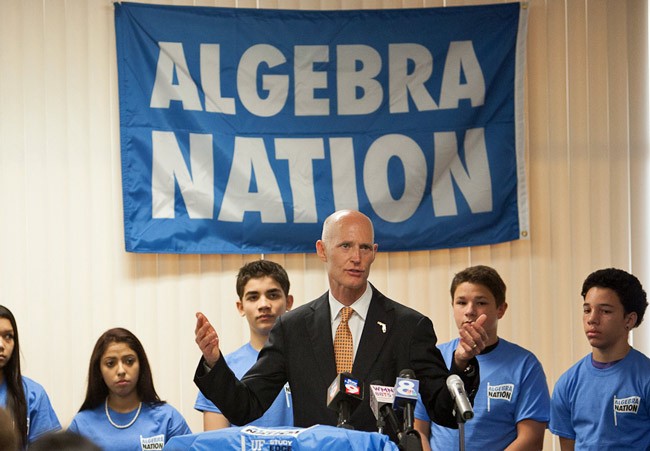
Gov. Rick Scott might clash with state senators in 2016 over the size of his tax-cut plans and how business recruitment dollars are banked.
Scott, addressing reporters Wednesday at an annual Associated Press media event in the Capitol, said he intends to ask lawmakers for a larger tax-cut package in 2016 than the $673 million he sought this year and also maintained support for placing business-relocation and expansion dollars into escrow.
The governor is particularly focusing on the permanent elimination of a sales tax on manufacturing equipment.
“We should be able to do it,” Scott said of creating a tax-cut package that features eliminating the manufacturing tax. “We’re growing revenue. We are paying down debts. We have budget surpluses every year going forward, so we should be able to do that year in and year out.”
Scott added that despite Florida having “the lowest state taxes per capita in the country,” taxes should be going down as there are “more people moving to our state.”
Lawmakers in 2013 approved a three-year moratorium on the manufacturing tax, but the tax is scheduled to be revived in 2017. Scott last year projected that companies will have to pay $142.5 million annually if the tax returns.
“If we do this this year we’re going to see so much growth in manufacturing, it will be a dramatic diversification of our economy,” Scott said.
In addition to Scott’s focus on the manufacturing tax, lawmakers have also submitted proposals for the 2016 legislative session that would cut taxes through a 10-day back-to-school sales tax holiday and reduce a commercial real-estate lease tax and the corporate income tax.
Senate President Andy Gardiner and House Speaker Steve Crisafulli, appearing separately after Scott, professed support for cutting taxes in the 2016 session.
However, Gardiner, an Orlando Republican who considers $250 million a starting point for the tax-cut discussions, said the return on each cut must be clearly identified.
“We want measurable goals and examples of where we can see that, yes, this tax is going to work,” Gardiner said.
He also expressed some apprehension about using all of the state’s projected $635.4 million budget surplus for tax cuts. The majority of the projected surplus is one-time revenue, which is not expected to recur year after year.
Crisafulli, a Merritt Island Republican, said a House tax-cut package will again come out of the Finance & Tax Committee but added that any cuts will help Florida’s economy.
“We all benefit when taxpayers are able to keep more of their hard-earned money in their pockets,” Crisafulli said. “Showing there is no better proof of that, Florida’s economy has continued to grow.”
GOP leaders prefer starting the tax-cut discussion at a more modest $250 million
Scott, who during his 2014 re-election campaign pledged $1 billion in cuts over two years, didn’t place a dollar figure on his tax-cut proposal other than to say it will be larger than what he wanted out of the 2015 session.
Lawmakers, who had to complete the budget in a June special session, ultimately sent $428.9 million in cuts to Scott’s desk.
Democrats said Wednesday the focus on using the surplus for tax cuts is misplaced.
House Minority Leader Mark Pafford, D-West Palm Beach, said that eliminating the manufacturing tax cut is “laughable” with the state facing issues such as shortfalls in health-care funding. Senate Minority Leader Arthenia Joyner, D- Tampa, added, “It’s my position that this surplus is not really a surplus, because we have not taken care of the needs of all of the people of the state of Florida.”
As for business incentives, Scott said a program known as the Quick Action Closing Fund, used by Enterprise Florida, needs to be reformed if the state wants to lure major corporate headquarters. But he also defended the state’s continued use of placing business-incentive money into escrow accounts.
“We can either give them the money upfront or we can do it the other way of doing it, say, ‘We’ll put the money in escrow (and) as you create the jobs we’ll give you the money,’ ” Scott said. “That is a way smarter way of doing it.”
Scott has been pushing business leaders across the state to lobby lawmakers to increase funding for corporate recruitment incentives, an action that hasn’t been well received by a number of lawmakers.
Earlier this year, Scott asked lawmakers to set aside $85 million for business incentives. The final budget for the fiscal year that started July 1 included $53 million for Enterprise Florida, of which $43 million was for incentives and $10 million was for marketing.
Gardiner has proposed that instead of putting the money into escrow, the state set aside $50 million to cover future economic incentive payments, which he has noted have never topped $20 million in a single year.
The capped funding, set up in a system similar to the state Department of Transportation’s 5-year work program, would be available for already-approved contractually obligated business incentives and in the future for performance payments.
Scott said he’d be “receptive” to any proposal that could produce a better return than the commercial escrow accounts.
Crisafulli, when asked if he supported the governor or Gardiner on budgeting incentive money, said the state needs to guarantee that cash will be readily available to get businesses to move to Florida and to create new jobs.
“I think the governor is in a situation where he has to have that money to show that we’re serious about what we’re doing,” Crisafulli said. “It’s important that people recognize that nothing takes place until those jobs are created.”
–Jim Turner, News Service of Florida





























Leave a Reply